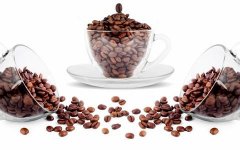Treatment of coffee beans in the sun and cleaning methods
Coffee beans must be disposed of immediately after harvest so as not to go bad. The producer will use two methods of treatment: the sun method and the cleaning method. An effective way to bask in the sun is to spread the berries flat in the yard and stir the dehydrated berries from time to time to make them evenly heated and breathable. Then put the dried berries into the machine, crush the shell, and remove the shell and a parchment film at the same time, separate the coffee beans, and then sort and bag them. In another way, the berries are mechanically removed, washed, dried and separated from the sheepskin-like outer membrane. Either way, the first goal is to reduce 65% moisture in coffee berries to only 10-12% raw (green) coffee beans.

One of the biggest challenges to making good coffee is to make sure to start with good raw coffee beans. Top manufacturers, such as Yili Coffee in Trieste, Italy, use many complex labor management techniques to reduce the proportion of defective coffee beans. These include the use of ultraviolet fluorescence analysis to pick out moldy beans and the use of tricolor images (yellow-green, red and infrared) to establish color fingerprints for each batch of beans. The Italian Coffee Company has partnered with the British company Sotex to develop a two-color light classification system to do the final quality control before raw coffee beans are roasted. The way is that the photodetector picks out the bad beans from the beans that fall on the plate, and then removes them separately with a blow from the air nozzle. This classification operates at a speed of up to 400 beans per second, which is not comparable to that of any man, and its accuracy is not as accurate as that of the most trained human eyes.
A perfectly mature raw coffee bean, made up of unusually thick-walled cells, can be as thick as 5-7 microns, which is rare in the plant world. During baking, these cells with a diameter of 30 to 40 microns act like microreactors, where all the important chemical reactions driven by heating take place, resulting in the fascinating taste and aroma of coffee. On the one hand, the cell wall of immature coffee beans is thin, and there is no important flavor protein precursor produced in the final stage of ripening. These important substances in the cells are also emptied from beans fermented by bacteria or mold.
Important Notice :
前街咖啡 FrontStreet Coffee has moved to new addredd:
FrontStreet Coffee Address: 315,Donghua East Road,GuangZhou
Tel:020 38364473
- Prev

The best coffee. The perfect espresso.
Few experiences in everyday life can compare to a good cup of coffee in terms of simple sensory pleasures. A cup of hot, smoking coffee, freshly brewed from freshly roasted beans, has a charming aroma that pulls sleeping people out of bed and lures passers-by into cafes. Millions of people around the world wouldn't be able to survive without a seizure caused by caffeine in their coffee.
- Next

General knowledge of fine coffee people who drink coffee every day live longer.
A study of 400000 people by the National Institutes of Health found that people who drank coffee every day lived longer than those who drank less or less. Coffee drinkers die of the heart, researchers say
Related
- Beginners will see the "Coffee pull flower" guide!
- What is the difference between ice blog purified milk and ordinary milk coffee?
- Why is the Philippines the largest producer of crops in Liberia?
- For coffee extraction, should the fine powder be retained?
- How does extracted espresso fill pressed powder? How much strength does it take to press the powder?
- How to make jasmine cold extract coffee? Is the jasmine + latte good?
- Will this little toy really make the coffee taste better? How does Lily Drip affect coffee extraction?
- Will the action of slapping the filter cup also affect coffee extraction?
- What's the difference between powder-to-water ratio and powder-to-liquid ratio?
- What is the Ethiopian local species? What does it have to do with Heirloom native species?

